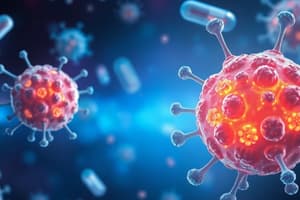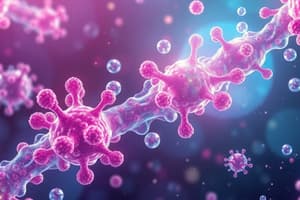Podcast
Questions and Answers
What is one mechanism bacteria use to resist tetracyclines?
What is one mechanism bacteria use to resist tetracyclines?
- Increasing drug concentration inside the cell
- Increasing ribosomal affinity for tetracyclines
- Active removal of tetracyclines via efflux pumps (correct)
- Enhanced binding of tetracyclines to ribosomes
Which type of bacteria shows limited effectiveness to tetracyclines?
Which type of bacteria shows limited effectiveness to tetracyclines?
- Certain strains of Escherichia coli
- Atypical pathogens such as Mycoplasma
- Some strains of Neisseria and Haemophilus (correct)
- Gram-positive bacteria like Streptococcus
What is the primary method by which tetracyclines inhibit bacterial growth?
What is the primary method by which tetracyclines inhibit bacterial growth?
- Binding to the 30S ribosomal subunit (correct)
- Enhancing tRNA production
- Altering the bacterial cell membrane
- Inhibiting DNA synthesis directly
What is one of the effects of tetracyclines on bacterial protein synthesis?
What is one of the effects of tetracyclines on bacterial protein synthesis?
Which infection is specifically mentioned as being treated with tetracyclines?
Which infection is specifically mentioned as being treated with tetracyclines?
What factor significantly contributes to the development of antibiotic resistance in tetracyclines?
What factor significantly contributes to the development of antibiotic resistance in tetracyclines?
Which mechanism of action is responsible for the bacteriostatic effect of tetracyclines?
Which mechanism of action is responsible for the bacteriostatic effect of tetracyclines?
Which of these is a common adverse effect of tetracyclines?
Which of these is a common adverse effect of tetracyclines?
How are most tetracyclines primarily excreted from the body?
How are most tetracyclines primarily excreted from the body?
Which condition is NOT an intended clinical use for tetracyclines?
Which condition is NOT an intended clinical use for tetracyclines?
Which factor affects the absorption of tetracyclines?
Which factor affects the absorption of tetracyclines?
What is a potential serious side effect of tetracyclines, especially in individuals with pre-existing conditions?
What is a potential serious side effect of tetracyclines, especially in individuals with pre-existing conditions?
Which statement about the pharmacokinetics of tetracyclines is accurate?
Which statement about the pharmacokinetics of tetracyclines is accurate?
Study Notes
Resistance Mechanisms
- Efflux Pumps: Bacteria use efflux pumps to actively remove tetracyclines from the cell, reducing drug concentration and effectiveness.
- Ribosomal Protection: Certain proteins can protect ribosomes from tetracycline binding, preventing the drug from inhibiting protein synthesis.
- Enzymatic Inactivation: Some bacteria produce enzymes that chemically modify and inactivate tetracyclines.
- Altered Membrane Permeability: Changes in the bacterial cell membrane can impede tetracycline entry, decreasing drug accessibility.
Antimicrobial Spectrum
- Gram-Positive Bacteria: Effective against Streptococcus, Staphylococcus, and some Enterococcus species.
- Gram-Negative Bacteria: Limited effectiveness; some strains of Neisseria and Haemophilus are susceptible.
- Atypical Pathogens: Active against Chlamydia, Mycoplasma, and Rickettsia.
- Other Infections: Utilized for treatment of acne, pneumonia, Lyme disease, and certain gastrointestinal infections caused by H. pylori.
Mechanism of Action
- Inhibition of Protein Synthesis: Tetracyclines bind reversibly to the 30S subunit of bacterial ribosomes.
- Prevention of tRNA Binding: They block the attachment of aminoacyl-tRNA to the ribosomal acceptor site, inhibiting the addition of amino acids to the growing peptide chain.
- Static Effect: Primarily bacteriostatic, meaning they inhibit bacterial growth rather than killing bacteria outright.
Resistance Mechanisms
- Bacteria develop resistance to tetracyclines through several mechanisms, including active removal by efflux pumps, protection of ribosomes from drug binding, enzymatic inactivation, and altered membrane permeability.
- Efflux pumps transport tetracyclines out of the bacterial cell, reducing intracellular drug concentration.
- Ribosomal protection proteins block tetracyclines from binding to ribosomes, preventing inhibition of protein synthesis.
- Some bacteria inactivate tetracyclines by producing enzymes that modify their structure.
- Changes in bacterial cell membrane permeability can hinder tetracycline entry, limiting drug concentration inside the cell.
Antimicrobial Spectrum
- Tetracyclines are effective against several Gram-positive bacteria, including Streptococcus, Staphylococcus, and some Enterococcus species.
- They have limited activity against Gram-negative bacteria, but some strains of Neisseria and Haemophilus are susceptible.
- Tetracyclines also effectively target atypical pathogens like Chlamydia, Mycoplasma, and Rickettsia.
- These drugs are used to treat various infections, including acne, pneumonia, Lyme disease, and H. pylori-related gastrointestinal infections.
Mechanism of Action
- Tetracyclines inhibit bacterial protein synthesis by binding to the 30S subunit of ribosomes.
- This binding prevents the attachment of transfer RNA (tRNA) carrying amino acids to the ribosomal acceptor site, blocking protein chain elongation.
- Tetracyclines primarily exhibit a bacteriostatic effect, meaning they inhibit bacterial growth rather than killing them outright.
Tetracycline Resistance
- Mechanisms of resistance are complex and involve multiple pathways within bacteria:
- Efflux pumps: These pumps actively expel tetracycline from the bacterial cell, reducing its concentration and effectiveness.
- Ribosomal protection proteins: These proteins bind to the ribosome and prevent tetracycline from binding to its target site, disrupting protein synthesis.
- Enzymatic inactivation: Some bacteria produce enzymes that chemically modify tetracycline, rendering it inactive.
- Factors contributing to resistance include:
- Overuse and misuse: Excessive use of tetracyclines in both human medicine and agricultural settings increases selective pressure for resistant strains.
- Horizontal gene transfer: Bacteria can readily share resistance genes with each other, rapidly spreading resistance.
Tetracycline Mechanism of Action
- Tetracyclines work by inhibiting bacterial protein synthesis, a crucial process for bacterial growth and survival.
- They achieve this by binding to the 30S ribosomal subunit, a key component of the bacterial protein synthesis machinery.
- This binding prevents the attachment of aminoacyl-tRNA, a molecule essential for translating genetic information into proteins.
- The result is a bacteriostatic effect, meaning that tetracyclines halt bacterial growth rather than directly killing the bacteria.
Tetracycline Side Effects
- Common side effects:
- Gastrointestinal disturbances: Nausea, vomiting, and diarrhea are frequently reported side effects.
- Photosensitivity: Tetracyclines can increase skin sensitivity to sunlight, leading to sunburn.
- Rare but serious side effects:
- Hepatotoxicity: Tetracyclines can damage the liver, especially in individuals with pre-existing liver dysfunction.
- Allergic reactions: Anaphylaxis, a severe allergic reaction, can occur in some cases.
- Tooth discoloration: Particularly important for children, tetracyclines can cause discoloration and enamel hypoplasia, making their use in pregnancy and young children generally discouraged.
Tetracycline Pharmacokinetics
- Absorption:
- Oral absorption of tetracyclines can be variable and is influenced by food and certain metal ions like calcium, magnesium, and iron.
- Distribution:
- Tetracyclines are widely distributed throughout the body and can even cross the blood-brain barrier, reaching the central nervous system.
- Metabolism and excretion:
- The liver primarily metabolizes tetracyclines, and they are mainly excreted through the urine, except for doxycycline, which is mainly excreted in feces.
Tetracycline Clinical Uses
- Infections:
- Respiratory tract infections: Tetracyclines are effective against various respiratory infections, including pneumonia and chronic bronchitis.
- Skin infections: They are commonly used to treat acne and rosacea.
- Sexually transmitted infections: Tetracyclines are used to treat chlamydia infections.
- Other uses:
- Lyme disease and anthrax: Specific tetracyclines are used to treat these infections.
- Periodontal disease: Tetracyclines can be used as adjunct therapy for this condition.
- Considerations:
- Dosing: The appropriate dosage of tetracyclines varies depending on the specific infection and the particular tetracycline used.
- Monitoring: Careful monitoring for adverse effects is essential, and therapy may need to be adjusted based on individual responses.
Studying That Suits You
Use AI to generate personalized quizzes and flashcards to suit your learning preferences.
Description
Test your knowledge on the mechanisms of antibiotic resistance, specifically focusing on tetracyclines. This quiz covers efflux pumps, ribosomal protection, enzymatic inactivation, and alterations in membrane permeability. Additionally, explore the antimicrobial spectrum against various bacterial pathogens.




